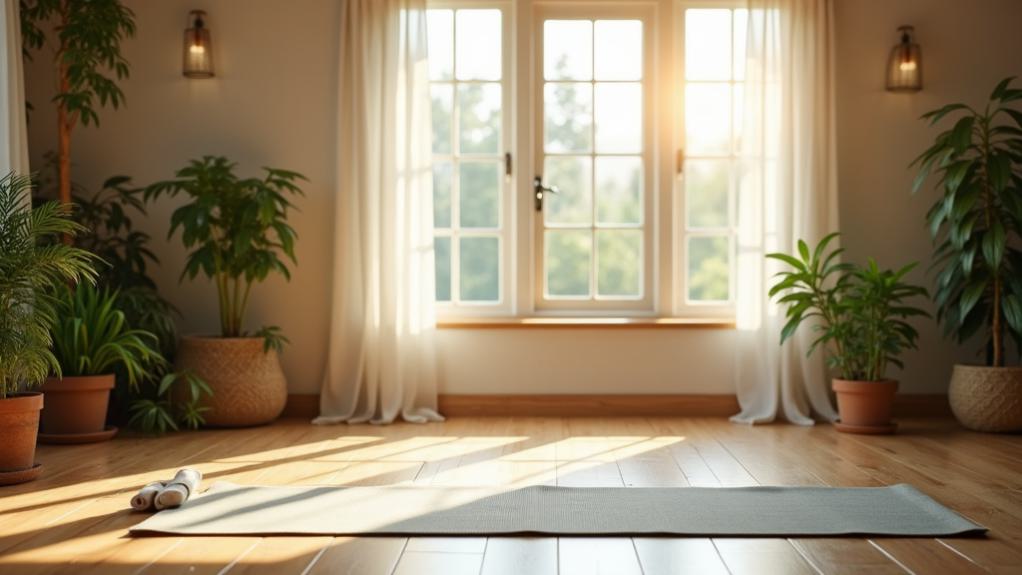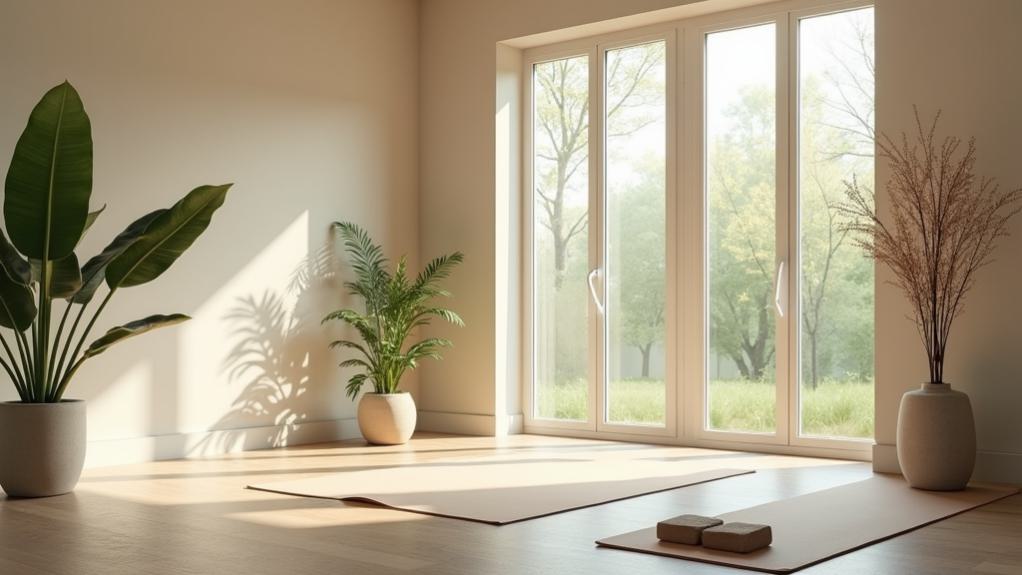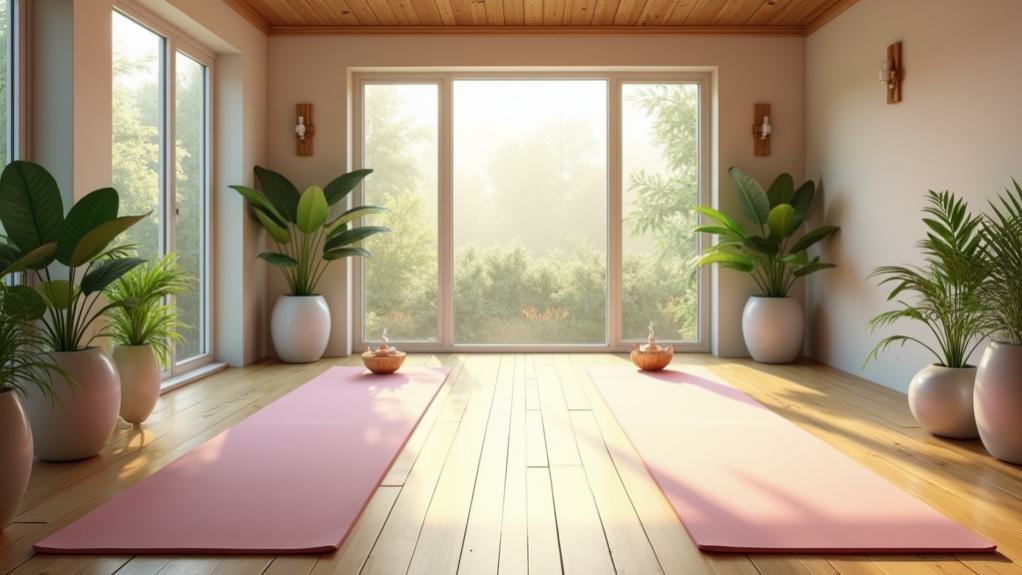Gentle yoga routines are perfect for women over 50, providing a safe and accessible way to improve flexibility, balance, and overall wellness. You can start with poses like Cat and Cow, Downward Facing Dog, or Modified Tree Pose, which cater to your needs and comfort. These routines also support joint health and mental clarity, helping reduce anxiety and promote relaxation. Remember to listen to your body and use props as needed, such as chairs or blocks, for added support. There’s so much more to explore on how gentle yoga can enrich your life and well-being.
Key Takeaways
- Gentle yoga routines enhance flexibility and balance, crucial for reducing fall risk in women over 50.
- Incorporating props like chairs and straps ensures safe practice and supports various fitness levels.
- Mindful breathing techniques promote relaxation and emotional well-being during yoga sessions.
- Modified poses such as Chair Pose and Modified Tree Pose accommodate limited mobility while maintaining strength.
- Regular practice improves joint health, mental clarity, and overall cardiovascular wellness.
Recommended Yoga Poses
When it comes to practicing yoga, choosing the right poses can make a significant difference, especially for women over 50. Gentle Yoga offers a wonderful way to address common concerns like back pain while promoting overall well-being.
Start with the Cat and Cow Pose to warm up your back and abdominal muscles. This pose not only helps alleviate stiffness but also supports emotional cleansing, making it ideal for your practice.
Next, try Downward Facing Dog; it stretches your calves, hamstrings, and back while building strength in your arms and shoulders, enhancing circulation and confidence.
For hip flexibility, the Modified Cobblers Pose is a safe option. It allows you to increase flexibility without straining your knees, which is essential as you age.
Incorporate the Modified Tree Pose to improve your balance and concentration—using props like chairs can make this pose more accessible.
Lastly, Child’s Pose serves as a restorative stretch, relaxing your back, arms, and neck. It’s a perfect moment for mindfulness and emotional reflection.
Benefits of Gentle Yoga
Gentle yoga offers numerous benefits that can markedly enhance your quality of life as you age. One significant advantage is improved flexibility and balance, essential for reducing the risk of falls, which can be a concern for women over 50. By engaging in gentle yoga, you’ll also support your joint health, alleviating symptoms of arthritis and making daily activities more comfortable and manageable.
Moreover, practicing gentle yoga can positively impact your mental health. It’s been shown to decrease anxiety and depression, contributing to your overall emotional well-being. You may find that regular sessions help you feel more centered and less stressed.
Another benefit worth noting is the promotion of better sleep quality. This is vital for recovery and overall wellness, especially if you’ve been experiencing sleep disturbances.
Also, gentle yoga supports cardiovascular health by helping to lower blood pressure and improve circulation, leading to a healthier heart.
Incorporating gentle yoga into your routine can create a ripple effect, enhancing not just your physical strength but also your mental resilience. You deserve this nurturing practice that supports your body and mind as you embrace this vibrant stage of life.
Safety Tips for Practicing

Practicing yoga can be a rewarding experience, but it’s vital to prioritize safety to fully enjoy its benefits. Start by consulting with your healthcare provider before beginning any yoga practice. They can help guarantee it’s safe based on your individual health conditions and needs.
Use props like blocks, straps, and chairs to provide support and stability during poses. This is especially important if you have limited mobility or balance issues.
Always practice on a non-slip surface and keep your area free from obstacles to prevent falls and injuries.
As you move through your practice, listen to your body. Avoid overexertion by respecting your limits; take breaks as needed, and modify poses to suit your comfort level.
Staying hydrated is essential, so drink water throughout your session. If you’re new to yoga, consider shorter sessions to gradually build your endurance.
Community Support Options
Many women over 50 find that connecting with a community enhances their yoga practice greatly. Joining local or online yoga classes not only fosters social interaction but also builds a sense of belonging, which can motivate you to stay consistent.
Engaging with peer support groups specifically for older women is invaluable, as it encourages shared experiences and mutual encouragement.
You might also explore resources like instructional videos and tutorials tailored for your age group, enabling you to practice safely and effectively at home.
Participating in workshops focused on senior yoga practices can deepen your understanding while connecting you with like-minded individuals who share your journey.
Don’t underestimate the power of sharing your progress within a supportive network. This connection can boost your confidence and create a sense of accountability, making your yoga practice even more enjoyable and rewarding.
Whether you’re attending classes or engaging online, having community support is essential in enriching your experience and ensuring you feel empowered in your journey.
Embrace the connections you make, and watch how they positively impact your yoga practice and overall well-being.
Yoga Modifications for Comfort

When it comes to yoga, using props like blocks, straps, or chairs can really enhance your comfort and support.
Modifying poses to incorporate chair yoga or adding cushions during seated stretches makes it easier for you to enjoy the practice without strain.
Don’t forget to focus on your breath; mindful breathing can help you relax and get the most out of your sessions.
Importance of Prop Usage
In your yoga journey, using props like blocks, straps, and cushions can make a world of difference. These tools enhance comfort and accessibility, allowing you to practice safely and effectively, no matter your fitness level or physical limitations.
By incorporating props, you can maintain proper alignment in your poses, which reduces strain on your joints—especially important if you’re dealing with issues like arthritis or decreased mobility.
Props enable you to modify poses to cater to your individual needs, helping you engage with less discomfort and greater ease. This not only promotes a more enjoyable experience but also encourages a mindful approach to your practice. You can focus on your breath and body sensations, fostering emotional well-being and relaxation.
Additionally, using props like chairs for standing poses or seated variations provides extra stability and support. This allows you to build strength and balance without the risk of falling.
Chair Yoga Adaptations
Embracing the use of props not only enhances your yoga practice but also opens the door to chair yoga adaptations, which can greatly benefit women over 50.
Chair yoga allows you to practice familiar poses while seated, providing stability and minimizing the risk of falls. This makes it an excellent choice if you have limited mobility or balance concerns.
You can modify traditional poses like Downward Facing Dog and Warrior II with the support of a chair. These adaptations help you build strength and flexibility without needing to get on the floor.
Incorporating props such as yoga blocks and cushions can further enhance your comfort and support, ensuring proper alignment and reducing strain on your joints.
Chair yoga is also fantastic for improving circulation, relieving tension, and promoting relaxation—key components of overall well-being for women over 50.
Plus, many chair yoga routines can be done in short sessions throughout the day, making it easy to weave gentle movement into your daily life without overexerting yourself.
Mindful Breathing Techniques
Mindful breathing techniques play an essential role in enhancing your yoga practice, especially as you navigate the unique challenges of being over 50. These techniques, like the 4-7-8 method, can reduce anxiety and promote relaxation, which is particularly helpful during emotional changes such as menopause. By focusing on deep diaphragmatic breathing, you encourage better oxygen flow, supporting your cardiovascular health and boosting overall energy levels.
Incorporating mindful breathing into your routine can improve mental clarity and concentration, helping you address common cognitive challenges. Practicing these techniques before and after yoga poses enhances body awareness, allowing you to listen to your body and adapt your practice according to your comfort levels.
Here’s a quick overview of mindful breathing techniques and their benefits:
| Technique | Benefits |
|---|---|
| 4-7-8 Method | Reduces anxiety, promotes relaxation |
| Ujjayi Breathing | Calming effect, maintains steady rhythm |
| Diaphragmatic Breathing | Improves oxygen flow, supports cardiovascular health |
Additional Poses to Try
Incorporating additional poses into your gentle yoga routine can enhance your strength, flexibility, and overall well-being. As you explore these yoga poses, you’ll find that each offers unique benefits tailored to your needs.
Start with Chair Pose, which can strengthen your legs and improve balance. If you need support, using a chair makes this pose accessible.
Next, try Warrior II; it builds stamina and opens the hips, helping you maintain lower body strength and flexibility.
Don’t forget Cobra Pose. This one enhances back strength and posture, and you can modify it by practicing on the floor or with a chair for support.
For a calming stretch, the Seated Forward Bend is perfect for your hamstrings. You can even use a strap or sit on a chair to make it more comfortable.
Lastly, give the Modified Tree Pose a go. This pose improves focus and balance, and you can use a wall or chair for added stability, addressing common balance issues as we age.
Understanding Fitness Levels

Understanding your fitness level is essential for choosing the right yoga practices that suit your body and experience. Evaluating where you stand can help you select routines that build strength safely and effectively. Here’s a helpful guide to understand different fitness levels:
| Fitness Level | Description | Recommended Yoga Practices |
|---|---|---|
| Not Active | Little to no regular exercise | Gentle routines to build strength and flexibility |
| Fairly Active | Some exercise, but not regularly | Moderate routines with challenging poses |
| Very Active | Regular, intensive physical activity | Advanced variations of poses, focusing on balance and strength |
If you’re classified as “Not Active,” start with gentle routines. For “Fairly Active” individuals, gradually incorporate more challenging poses to enhance your practice. If you’re “Very Active,” focus on advanced variations, but always listen to your body to avoid overexertion. Remember, gradual progression is key for everyone. It minimizes injury risk and makes your yoga journey more enjoyable and sustainable. Setting realistic goals based on your fitness level will help you track your progress as you embrace yoga.
Conclusion
Gentle yoga can be a wonderful way to enhance your well-being and embrace movement in a nurturing way. By incorporating recommended poses, prioritizing safety, and exploring modifications, you can enjoy a fulfilling practice that fits your unique needs. Remember, it’s about listening to your body, connecting with your breath, and finding joy in each session. So go ahead—stretch, strengthen, and support yourself as you commence this beautiful journey of wellness and community.
Join our list
Subscribe to our mailing list and get interesting stuff and updates to your email inbox.

